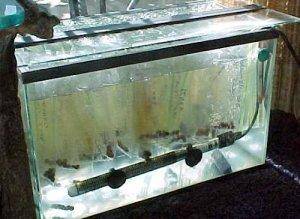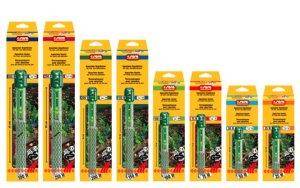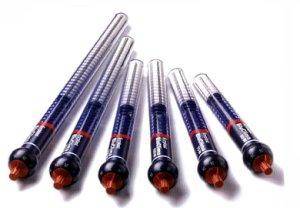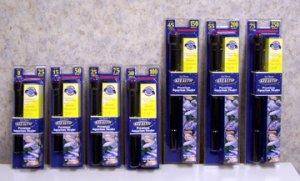The Ultimate Guide to Aquarium Heaters: Types, Usage, Tips, and FAQs



Quick Links - Topics Covered
Brief Description
This guide covers everything you need to know about aquarium heaters: their importance, types, installation, maintenance, and product recommendations. It includes tips for choosing the right heater size and reputable suppliers, as well as answers to common questions.
Why You Need an Aquarium Heater
Aquarium heaters help maintain a stable water temperature, which is essential for the health of fish and aquatic plants. Many tropical species need water temperatures between 24-28°C (75-82°F). For these species, consistent warmth is vital for their metabolism and overall well-being. Sudden temperature changes can stress fish, leading to illnesses or even death.
In saltwater tanks, keeping a steady temperature is even more important. Fluctuations can change the water's specific gravity and reduce its ability to hold oxygen. This change can lead to stress-related health issues for fish and other marine life. Thus, using a high-quality heater is crucial in saltwater aquariums.
Types of Aquarium Heaters
There are different aquarium heaters, each suited for specific needs. Here’s a breakdown:
1. Glass and Plastic Submersible Heaters
These heaters are the most common. They come with a heating element inside a glass or plastic case and include an adjustable thermostat. While they are affordable, they can be fragile. Handle them with care to avoid damage. Additionally, some fish, like large cichlids from South America, can break these heaters if they bump into them. If the glass on the heater breaks, you should not use it again, even if it seems to work fine. Broken glass poses a risk to both fish and electrical safety.
2. Titanium Heaters
Titanium heaters are very durable and do not break easily. They are ideal for both freshwater and saltwater tanks. Many models have separate thermostat controls, providing precise temperature settings. Although they are more expensive, they last longer and offer better heat distribution. These heaters are popular in ponds too, showing they work well in large water volumes.
Advantages of Titanium Heaters:
- Unbreakable metallic casing makes them safer for fish.
- Resistant to corrosion, perfect for saltwater tanks.
- Suitable for large aquariums and ponds, with wattages up to 800W.
3. Integrated Filter Heaters
Some filters come with built-in heaters, combining both functions in one unit. This can save space, but it also has downsides. For example, if you need to turn off the filter for maintenance, you lose heating. Plus, these heaters are not as easy to reach when you need to adjust the temperature or clean them.
How to Install and Use Aquarium Heaters
Proper Placement
- Place the heater near the water flow, usually next to the filter outlet. This helps distribute the heat evenly across the tank.
- Submerge the heater fully if it's rated as submersible. Never put it directly on the substrate; this can cause uneven heating.
Positioning the Thermostat
If your heater has a thermostat, keep it where you can easily adjust it. This allows for quick changes if the water temperature isn't as desired.
Using a Thermometer
Install a thermometer to monitor the water temperature. It’s a simple tool that ensures your heater maintains the correct temperature.
Choosing the Right Heater Size
The heater size depends on your tank’s volume and the room's temperature. As a general rule, use a heater that provides 1 watt per liter (3.78 watts per US gallon). Larger tanks may need more than one heater to keep the water evenly warm. Use our heater size calculator for specific recommendations.
Here's a quick reference for heater sizing:
| Wattage | Liters | UK Gallons |
|---|---|---|
| 50W | 20-50L | 4.5-11 UK Gall |
| 100W | 50-100L | 11-22 UK Gall |
| 200W | 100-200L | 22-44 UK Gall |
| 300W | 200-300L | 44-66 UK Gall |
| 400W | 300-400L | 66-88 UK Gall |
Maintenance Tips & Troubleshooting
- Clean Regularly: Wipe the heater with a soft cloth every 2-4 weeks. This prevents scale buildup, which can lower its efficiency.
- Check for Damage: Look for cracks or other damage, especially in glass models. If you find any, replace the heater right away.
- Keep a Spare: Always have a backup heater. If your main heater fails, a spare prevents sudden temperature drops in the tank.
- Initial Setup: Run the heater for 24 hours during setup. This ensures it holds the desired temperature before adding fish.
- Water Changes: Unplug the heater when changing water if the level drops below its minimum immersion line. If you need to remove it, switch it off 10 minutes beforehand to let it cool down.
Brand Recommendations & Comparisons
- Jewel: Known for reliability and affordability. Sizes range from 50 to 300 watts. No temperature scale, requiring some trial and error for adjustment.
- Visitherm: Well-constructed with an easy-to-read temperature dial. Available in glass and plastic (Stealth) models, ranging from 25 to 300 watts. Pros: Clear temperature scale, durable. Cons: Glass model can be fragile.
- Rena: High-quality with triple-sealed protection. The Rena Smart Heaters include electronic sensors for automatic shutoff when not submerged. Pros: Fast heat transfer, durable glass. Cons: Pricier than other models.
- Finnex: Offers titanium heating tubes with compatible controllers. Available up to 800W. Pros: High durability, precise temperature control. Cons: Requires separate controller.
- Aqua Medic: Produces high-end controllers for titanium heaters. Pros: Twin display units for monitoring, ideal for large tanks. Cons: Higher cost.
Note: Manufacturers may change their products over time. Always check the latest specifications and details from the manufacturer when buying a heater to ensure it meets your tank’s needs.
Suppliers of Aquarium Heaters
If any of the links in the list below do not work, please report it using the form at the bottom of this page.
- thatpetplace.com - A broad selection of aquarium heaters and equipment at competitive prices.
- marinedepot.com - A favorite for saltwater aquarium enthusiasts, offering heaters for both marine and freshwater setups.
- petsmart.com - A well-known pet store chain with a wide online catalog. Offers heaters for different tank sizes and types.
- swelluk.com - UK-based retailer with a large selection of heaters, including submersible, titanium, and integrated models.
- pondsolutions.com - Ideal for pond owners seeking durable, high-wattage heaters for large volumes of water.
Frequently Asked Questions (FAQ)
1. Do I need a heater for my aquarium?
If you keep tropical or subtropical fish, yes. A heater keeps the water warm and stable. Coldwater species, like goldfish, do not need a heater.
2. How do I install a fish tank heater?
Place the heater near flowing water, usually next to the filter outlet. Attach it with rubber suckers or brackets. Make sure it's fully submersible and use a thermometer to check the temperature.
3. How big of an aquarium heater do I need?
The rule is 1 watt per liter (3.78 watts per US gallon). For bigger tanks, you may need more heaters to keep the temperature even.
4. Can I use a larger heater in a small tank?
Yes, but it may overheat the water. It’s better to use the right wattage for your tank size to avoid stressing your fish.
5. How can I tell if my aquarium heater is working?
Most heaters have an LED light that shows when they’re heating. Use a thermometer to monitor the water temperature. If the temperature isn’t right, test the heater in a container with cold water.
6. How long should I leave the heater switched on?
Leave it on all the time. The heater will automatically turn on and off to keep the water at the right temperature.
7. What fish can go into a room temperature tank?
Coldwater fish like goldfish and koi do well in room-temperature tanks. Most tropical fish need a steady temperature between 24-28°C (75-82°F), which requires a heater.
8. How do I prevent my heater from overheating the tank?
Use a thermometer to watch the water temperature. If it gets too hot, do a partial water change to cool the tank. Remove the lid to help release heat and check the heater for problems.
9. Which brands of aquarium heaters are reliable?
Brands like Jewel, Visitherm, Rena, Finnex, and Aqua Medic are known for quality. Choose based on your tank’s size, water type, and specific needs.
10. How often should I clean my aquarium heater?
Clean it every 2-4 weeks to stop scale from building up. This keeps it working well and extends its life.
11. Can I use a heater guard?
Yes, a heater guard protects your fish from burns and stops the heater from getting damaged.
Conclusion
Aquarium heaters are key to a stable environment for your fish and plants. Knowing the types, installing them right, and doing regular maintenance helps you choose the best heater for your tank. Always use a thermometer to monitor the temperature, pick the right wattage, and select a reliable brand to keep your aquatic life healthy.
Heater Installed in an Aquarium
Sera Aquarium Heaters
Ferplast Aquarium Heaters
Stealth Aquarium Heaters
Image sources: practicalfishkeeping.co.uk.







